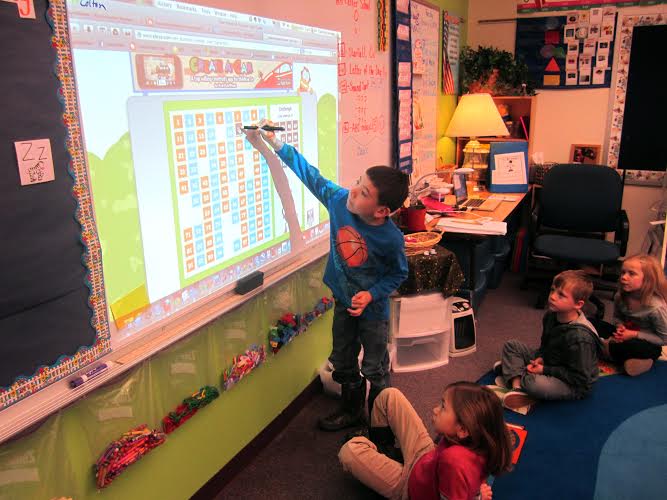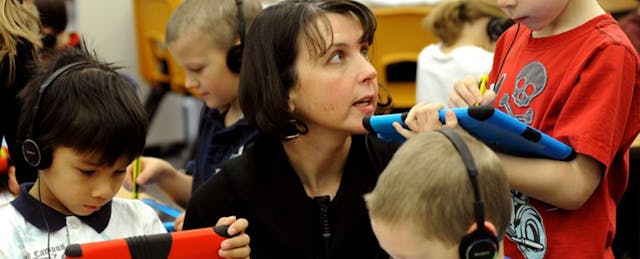What would you do with $20,000 and the freedom to use it all for edtech in your classroom?
Last spring, a private donor funded an experiment. As an Eagle Cliffs Elementary classroom teacher in Billings, Montana, I had the opportunity to write to our Billings Education Foundation for a mini-classroom grant--a mere one thousand dollars. My classroom grant idea? Simple: two iPads.
The idea caught the eye of Mr. Wardell, a generous annual donor to the Foundation’s classroom grants, who then asked, “What would you really like to do in your classroom, and what would you need to equip your room the way you would prefer?”
If there was ever an opportunity to dream big, this was it.
Go big (and blended) or go home
Our school district’s technology integration specialist and I sat down together and decided to dream big. Our dream list included the latest educational technologies, including an interactive whiteboard projector, an amplification system and an iPad for each student. We wrote up a proposal titled “The Innovative Primary Classroom,” and hoped that Mr. Wardell would fund one or two items from our list, whether it be 20 Kindergarten iPads, a Laser Printer for QR codes, or another requested item.
But he didn’t just fund an item or two; he gave us $20,000. To our amazement and delight, Mr. Wardell was ready to support our project 100%--given he got an answer to one important question: “Are these technologies, particularly the iPads, a tool or a toy?” And so began our great experiment using one-to-one iPads in Kindergarten, putting 21st century tools in the hands of 21st century learners: the “Connected Kinders.”

Getting connected in the classroom routine
In most traditional classrooms, mornings begin with an independent activity. Each child has the same seatwork laying on his/her desk, most likely a worksheet. The children receive about ten practice questions on a skill, and while the students are working, the teacher does an incredible juggling act to take care of housekeeping items before the “real” learning begins.
This is not the case for the Connected Kinders.
“Real” learning occurs the moment children enter the classroom with edtech. instead of just engaging in busy-work, children use the interactive whiteboard to move their name to hot or cold lunch when they walk in the classroom, and then proceed to their table groups. At a glance, I can use the whiteboard to record my attendance and lunch count. By the time I have sent attendance to the office, the students are all intently working on their iPads. They have already logged into the Teach Me Kindergarten app and are reviewing both English Language arts skills and mathematics. The app records progress, and levels the questions based on previous answers.
While the students are engaged in their apps, I am free to listen to special news, read any parent correspondence, and support or extend students that could use some extra attention. Instead of 5-10 questions on a traditional worksheet, within the first twenty minutes of class, the Connected Kinders get over thirty supported practice questions on a variety of skills--at their exact level.
Enhancing instruction--not replacing it
Meaningful learning opportunities, like the “Teach Me” activity above, continue throughout the day and across all curricular areas. But this isn’t about replacing instruction.
Tablets and other technology tools are not used in every lesson, nor are they used at a designated “technology time.” The Connected Kinders still do all the traditional and important developmental kindergarten activities--paint, color, etc. Rather, the technology components are integrated into lessons where and when the use of the technology will enhance the learning of the objectives. No matter what the subject area or objective, when I look at why the use of the iPad is so effective, three key components surface: increased engagement, immediate feedback, and differentiated instruction.
Take, for example, learning proper letter formation for writing. The app Letter School certainly enhances this important objective and the Connected Kinders use the app weekly for handwriting practice. As the students practice their letters, the app instructs about each one, tracing the path of proper formation with interesting and fun graphics.
When the Connected Kinders are working on Letter School, every student is focused and on task, invested in earning letter stars and making the app’s graphics work their magic. When it comes to using technology, time on task equals time on learning.
Walking hand in hand with student engagement is the power of feedback--when students are using the iPad, they receive immediate and meaningful feedback about their work. In Letter School, for example, if the student does not start the letter in the proper place, he/she can’t move on, while the app directs the student on where to begin the letter. We have all heard practice makes perfect and with the immediate, specific feedback from Letter School, students get perfect practice.
The power to differentiate
iPads allow for powerful differentiation. Every student has the opportunity to work at his/her level and pace. The right apps allow students to develop weak areas through repeated practice and/or move students up to the next challenge.
For instance, we use an app called Quick Math. Depending on the student’s level or need, the app gives students the opportunity to practice everything, from basic facts to mental double digit computations. All students are working in a similar interface, and the app tracks each students’ individual progress.
But the biggest benefit? Students work better themselves without the stigma of having a completely different activity from the student next to them.
Getting results
Is technology predominantly a tool or toy? According to my students’ results, most definitely a tool. The Connected Kinders, as a group, performed higher than any group I had ever taught, and further, they were performing above grade level peers in the other Eagle Cliffs classrooms. Taking reading, for example; all the students met the benchmark reading level for kindergarten. In fact, 15 of my 22 students were reading above grade level. Of those 15 above grade level, 8 were reading an entire year ahead of grade level benchmarks. But why is that? How did technology contribute to that?
Our purposeful technology integration has increased student engagement, provided students with meaningful, immediate feedback, and allowed for differentiation. This powerful combination has created an ideal learning environment, and the technology has allowed me to cultivate learning potential previously untapped in these young learners.
Yes, Kindergartners can and do learn great amounts without technology, and children don’t always need iPads to learn--but doesn’t every child deserve a Connected Kinder experience?


